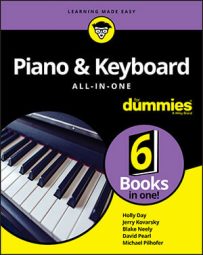After much deliberation, and for whatever reasons, you decide to buy a digital keyboard over an acoustic one. Think your job is done? Not so fast, pal. Now you must decide what type of digital keyboard you want:
Digital pianos and organs
Arrangers
Stage pianos
Workstations
Synthesizers
Don’t assume that you’ve necessarily gone the cheaper route by selecting a digital keyboard as your instrument of choice. These instruments can be quite expensive, sometimes costing more than an acoustic piano. But they’re also very versatile.
Here are a few things you can count on:
All digital keyboards today use sampled sounds, which vary in quality.
You can choose from a variety of keyboard actions, or touch sensitivity — everything from nonresponsive action to weighted-action keyboards designed to mimic the touch and feel of an acoustic piano.
The three common keyboard sizes are standard 61-key, 76-key, and 88-key.
Digital keyboards have varying degrees of portability.
Nearly all models come with a music rack, a plug-in sustain pedal, and MIDI and/or USB connection capability.
Digital pianos and organs
The two types of digital piano or organ for home use are
Portable models.
Upright and grand models.
Not surprisingly, the portables are more portable than the uprights and grands, which are meant to occupy a relatively permanent spot in your home. Both come with built-in speakers, although the speakers are smaller on the portable models. Both usually offer a few sound options like acoustic piano, electric piano, organ, and maybe vibes. They come with a music rack, a stand, and a plug-in pedal.
If you’re looking exclusively for a digital organ, some very attractive models come with dual manuals and multiple organ effects like draw bars and rotary sound.
Arrangers
If you’re looking to have lots of fun with different sounds and accompaniment features and you’re not concerned with finding the best acoustic piano samples, an arranger is the digital keyboard for you. This type is loaded with “one-man band” features, like scads of sounds (500 or more); automatic drum, bass, and chord accompaniment; and recording and playback. Lower-end models are quite inexpensive and very portable.
Stage pianos
These keyboards, made for onstage performing, offer more professional keyboard sounds. If you’re going to be the keyboard player in a band, or even a solo act, and will be gigging around town, the stage piano may be the choice for you. It doesn’t have built-in speakers, so you need to have an external amplifier and speaker to hear yourself play, but you can plug in headphones.
Also, a stage piano doesn’t have as many functions as an arranger. Stage pianos come with a music rack and sustain pedal, but you need to purchase a keyboard stand and other accessories separately.
Workstations
Essentially a computer built into a keyboard, a workstation has everything: top-of-the-line sound samples, sequencing, recording and editing, and computer integration. These babies can be quite expensive, but if you’ve got big musical dreams, you may want to try one out.
Synthesizers
You can still buy a good ol’ synthesizer and manipulate waveforms and filters, and work with both analog and digital sounds. Today’s synthesizers come with more sounds to work with than older models, letting you go to town with some good preset sounds.
Avoid obsolescence
As with computers, keyboards become outdated as quickly as they reach the stores. But keyboard manufacturers are constantly trying to make products that won’t become obsolete by creating keyboards that can be upgraded or added to as technology advances.
Ask the manufacturer or a salesperson the following questions:
Can I add memory? More memory means the ability to accommodate new sounds, software, and hardware at a later date.
Is the unit upgradeable?
Can I purchase extra sound cards or libraries?
Is the company still making this model or series? If not, the keyboard is already headed toward the land of obsolescence.
Know the digital features you want
Make a list of the digital keyboard features that are important to you before you even start shopping. This list runs through digital keyboard features and tells you which keyboards to turn to for them:
Realistic piano sound: Look at the home digital pianos with the best piano samples.
Realistic piano action: Look at the home digital pianos with the best touch-sensitive keyboards and the best weighted-key action.
Built-in speakers: Home digital pianos, for sure.
To perform onstage: Look at stage pianos, and keep in mind that you also need amplification.
Portability: Look at stage pianos and arrangers.
Multi-note polyphony: Look at home digital pianos, stage pianos, and workstations. The bigger the number, the more notes you can play at once, so try for at least 32-note polyphony. Some models even have 128-note polyphony, which is excellent.
Multi-timbral: Look at arrangers and workstations for this ability to play more than one sound at the same time.
MIDI capability: Nowadays, they all have this.
Pitch bend and modulation: Look at arrangers, synthesizers, and workstations to make your sounds say “wah wah” and “woob woob.”
Sound editing: Look at workstations if you want to change the sounds, making the piano brighter, the horns brassier, and the goose calls goosier, for example.
Internal recording, editing, and sequencing: Want to record what you play without using external recorders or a computer? You need a sequencer.
Automatic rhythm, harmony, and bass accompaniment: Look at arrangers.
Strange sound effects: Look at synthesizers if you want to program your own sounds. Be aware that some synthesizers are monophonic.
Other mumbo-jumbo: Flash ROM, DSP plug-ins, BIAS Peak, sub-oscillators, vocoders, modeling filters, arpeggiators — all this is very cool, but what does it have to do with you playing music? Not much. It simply indicates that your model is on the cutting edge of current keyboard features.

